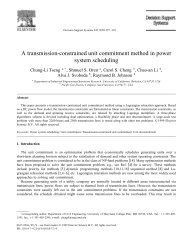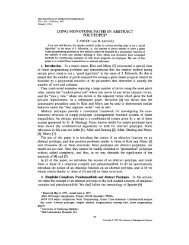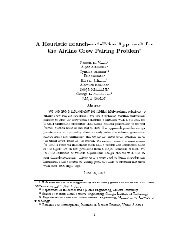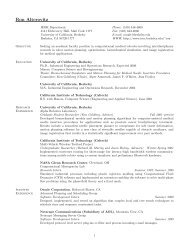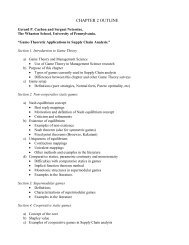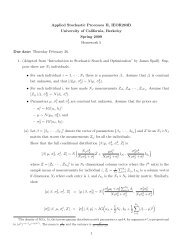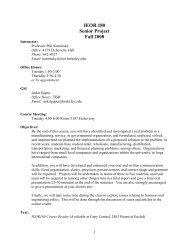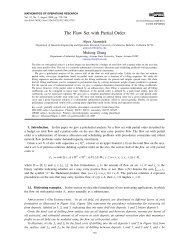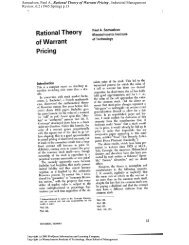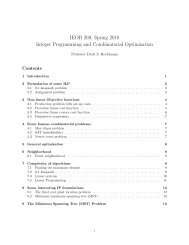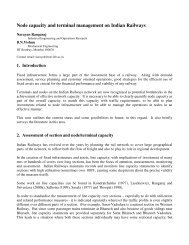IEOR 130 Methods of Manufacturing Improvement Fall, 2013 Prof ...
IEOR 130 Methods of Manufacturing Improvement Fall, 2013 Prof ...
IEOR 130 Methods of Manufacturing Improvement Fall, 2013 Prof ...
You also want an ePaper? Increase the reach of your titles
YUMPU automatically turns print PDFs into web optimized ePapers that Google loves.
<strong>IEOR</strong> <strong>130</strong> <strong>Methods</strong> <strong>of</strong> <strong>Manufacturing</strong> <strong>Improvement</strong><br />
<strong>Fall</strong>, <strong>2013</strong><br />
Pr<strong>of</strong>. Leachman<br />
Homework Problems #6<br />
Due Tuesday Oct. 17, <strong>2013</strong><br />
1. Data in a factory has been collected on the performance <strong>of</strong> five types <strong>of</strong> machines, as<br />
displayed in the following table. The machines are all used in the same process flow.<br />
Shown in the table for each machine type are the theoretical production time per lot<br />
(TPT) in hours, the number <strong>of</strong> lots (NL) processed, the actual production time (PT) in<br />
hours and the down time (DT) in hours. Total time for each machine type is 24 hours.<br />
Machine TPT NL PT DT<br />
Type<br />
A 1.0 20 21.0 2.5<br />
B 1.0 21 21.5 1.5<br />
C 0.5 38 20.0 0.5<br />
D 0.5 36 20.0 3.0<br />
(a) Calculate the availability, the utilization <strong>of</strong> total time and the utilization <strong>of</strong> availability<br />
for each machine type. Calculate the OEE <strong>of</strong> each machine type. Assume quality<br />
efficiency is 100% for all machine types.<br />
(b) Suppose it is possible to reduce down time by 0.5 hours per day for any <strong>of</strong> the four<br />
machine types. However, it is not possible to reduce down time for more than one <strong>of</strong> the<br />
machine types, i.e., you must pick one machine type and reduce down time <strong>of</strong> that<br />
machine type. For which one do you think it would be most beneficial to fab<br />
performance? Why? How will fab performance improve?<br />
(c) Suppose it is possible to increase rate efficiency <strong>of</strong> any <strong>of</strong> the four machine types. For<br />
which one do you think it would be most beneficial to fab performance? Why? How will<br />
fab performance improve?<br />
2. A wafer fabrication plant produces 800 wafers per day <strong>of</strong> a memory device. The line<br />
yield is 100%. The steppers are the bottleneck equipment. At present, the OEE <strong>of</strong> the<br />
steppers averages 0.667, the down time averages 10% and the idle time averages 5%. The<br />
quality efficiency for the steppers is 100%. Considering all photo steps to make the<br />
memory device, the total theoretical process time per wafer is 0.5 hours.<br />
(a) How many steppers are operating in the plant?<br />
(b) What is the rate efficiency <strong>of</strong> the steppers?<br />
1
(c) What rate efficiency would be sufficient to reduce the number <strong>of</strong> operating steppers<br />
by one without reducing the output?<br />
3. Two alternative processing machines are under consideration. Statistics about machine<br />
performance and maintenance are as follows:<br />
Machine Rework Scrap Avg. PM Avg. Machine Avg. Process time<br />
Rate Rate Hours/Week Failures (Hours) (Hours/lot-pass)<br />
MTBF MTTR<br />
A 0.01 0.001 16 200 8 0.55<br />
B 0.02 0.006 18 100 6 0.50<br />
Assume the fab operates 168 hours per week. The machines process one lot at a time.<br />
When rework is required, the lot must be processed a second time. The average<br />
process time for the second pass is the same as for the first pass. The chance <strong>of</strong> a third<br />
pass is negligible.<br />
(a) What is the average availability <strong>of</strong> each machine type?<br />
(b) The two machines have the same price. From a productivity point <strong>of</strong> view, which one<br />
would you recommend? Explain.<br />
4. An I Line stepper is the bottleneck <strong>of</strong> a small fabrication facility, and management<br />
desires to maximize its output rate. When equipped with a brand new bulb, the lamp<br />
intensity <strong>of</strong> the stepper is approximately 1,000 mW/cm2. The intensity declines after<br />
every wafer exposure until the bulb is replaced. The photo engineer has estimated the<br />
lamp intensity function to be LI(n) = 1,000(0.9994) n , where n refers to the nth wafer<br />
exposed since the bulb was replaced and LI(n) is the lamp intensity realized for the nth<br />
wafer. The total machine down time to replace the bulb and re-qualify the stepper is four<br />
hours. Other stepper data: wafer exchange time XT = 13 seconds, initial alignment time<br />
AT = 27.5 seconds, and move and align time MT = 0.5 seconds. There is only one<br />
exposure step performed by the stepper, with NE = 60 and EE = 1,000 mJ. No blading is<br />
required.<br />
Consider three possible frequencies for changing the bulb: once every 100 wafers, once<br />
every 1,000 wafers, or once every 5,000 wafers. Which frequency would maximize<br />
n<br />
n<br />
i 1<br />
a<br />
stepper output rate? Explain. (Useful fact from algebra: a a .)<br />
i1<br />
1<br />
a<br />
5. In a 24-hour period, a particular photo exposure machine had 2.5 hours <strong>of</strong> down time.<br />
Its rate efficiency was 85 percent. It completed processing <strong>of</strong> 35 lots, but 5 <strong>of</strong> these were<br />
the second run on a lot previously processed (i.e., 5 lots were reworked). The average<br />
process time per machine cycle was 0.5 hours. (One lot is processed per machine cycle,<br />
and a rework lot takes the same amount <strong>of</strong> time as a first-pass lot.)<br />
2
(a) Estimate the availability, the utilization <strong>of</strong> availability and the OEE <strong>of</strong> the<br />
machine for that 24-hour period.<br />
(b) An engineering change to the machine is under consideration. The change will<br />
reduce the rework rate to about 6 percent, but it will increase the average process<br />
time by 2 percent. (Theoretical process time will not be changed.) Assuming the<br />
24-hour period reflected average conditions, estimate what the OEE score will be<br />
if the engineering change had been implemented. Assume the number <strong>of</strong> fab starts<br />
will be increased just enough so that the utilization is held constant.<br />
Now suppose it is not known how low the rework rate will be after the engineering<br />
change, but it is known that average process time would rise by 2 percent. Find the upper<br />
limit on the rework rate after the change such that the engineering change will not<br />
decrease OEE from its value in part (a). Once again, assume the fab starts would be<br />
adjusted so that the utilization is held constant.<br />
6. A semiconductor factory producing 0.8 micron products utilizes 5X G Line stepper<br />
machines to perform photolithography. The machine works as follows. One or two<br />
cassettes <strong>of</strong> 25 wafers each may be placed in the stepper by the operator. The operator<br />
must enter a recipe into the machine and place the proper reticle (i.e., the photomask) in<br />
the machine before starting the machine. The machine accommodates up to six reticles in<br />
an internal magazine. A new cassette, recipe and/or reticle can be tendered to the machine<br />
while it is running on another cassette/reticle/recipe combination.<br />
Mechanical apparatus inside the machine move wafers one at a time out <strong>of</strong> the input<br />
cassette and onto an X-Y stage where the exposures will take place. The machine<br />
performs the lithography exposures on the first wafer, then the completed wafer is moved<br />
to an empty cassette while the second wafer is moved onto the X-Y stage. The fixed time<br />
to move a completed wafer <strong>of</strong>f the stage and replace it with the next wafer to be<br />
processed is called the wafer exchange time (XT).<br />
After a wafer is moved onto the X-Y stage, the machine performs an aligning procedure<br />
to properly orient the wafer level and straight with the camera lens. The fixed time to<br />
perform this initial alignment is called the alignment time (AT).<br />
The 5X stepper performs multiple exposures, one at a time. (The name "stepper" comes<br />
from the fact that it performs multiple "steps" across the wafer surface.) Each exposure<br />
encompasses a small number <strong>of</strong> die. The number <strong>of</strong> exposures (NE) required to fully<br />
process a particular wafer type is a given factor which depends on the size <strong>of</strong> the die and<br />
the exposure field size <strong>of</strong> the machine.<br />
The process recipe calls for a certain exposure energy (EE) to be achieved, measured in<br />
milli-Joules (mJ). The time required to perform this exposure (ET) equals EE divided by<br />
the lamp intensity (LI) <strong>of</strong> the machine, where LI is measured in milli-Watts per square<br />
centimeter (mW/sq cm). LI depends on the condition <strong>of</strong> the exposure bulb and the quality<br />
<strong>of</strong> the optical path inside the machine.<br />
3
After a single exposure is completed, the X-Y stage moves the wafer over for the<br />
exposure <strong>of</strong> the next field. The fixed time for the mechanical apparatus to move the wafer<br />
and re-align the camera is called the move time (MT). There is no MT before exposing<br />
the first die; all initial motion <strong>of</strong> the wafer on the X-Y stage is included in AT.<br />
For the die types produced in this factory, there are no "test keys" printed on the wafers.<br />
The entire wafer surface is printed with product dice.<br />
After exposures <strong>of</strong> all wafers in the cassette are completed, the cassette can be removed<br />
from the machine and the exposed wafers are then sent through a development process.<br />
(Similar to the way the machine can hold two cassettes <strong>of</strong> inbound wafers, there is room<br />
in the machine for two outbound cassettes. A full outbound cassette can be removed from<br />
the machine while it continues to process wafers into the other cassette.) After<br />
developing, the wafers are inspected under a microscope. If for some reason the exposure<br />
was mis-aligned with earlier mask layers, the current layer can be stripped <strong>of</strong>f in an acid<br />
bath, and the wafers sent back through the stepper for a second try. This repetition is<br />
known as rework. Let RW denote the fraction <strong>of</strong> total wafer operations performed on the<br />
5X stepper that are rework.<br />
The operational procedures followed in the factory sometimes result in the machine being<br />
completely flushed out <strong>of</strong> wafers and falling idle. For quality control purposes, the<br />
machine might be deliberately stopped after processing one wafer and held idle while<br />
waiting for the results <strong>of</strong> the after-develop inspection. When the machine is to be used<br />
again after becoming idle, the machine is inactive while the operator puts in a new reticle,<br />
puts in a new cassette, enters the appropriate recipe, and starts the machine. It then takes<br />
the machine some time to bring the first wafer from the inbound cassette to the X-Y stage<br />
in order to start the basic processing cycle described above. The sum <strong>of</strong> all these delay<br />
times is called a setup time (ST). Let WPS denote the average number <strong>of</strong> wafers<br />
processed between setups.<br />
The industrial engineer for the fab has collected the following data about a particular 5X<br />
stepper in the factory:<br />
Parameter Theoretical Average<br />
LI 770 mW/sq cm 720 mW/sq cm<br />
MT 0.46 sec 0.47 sec<br />
AT 27.0 sec 29.0 sec<br />
XT 12.0 sec 12.0 sec<br />
ST<br />
150 sec<br />
(a) Provide a formula for the theoretical processing time (seconds per wafer) as a function<br />
<strong>of</strong> the number <strong>of</strong> exposures per wafer (NE), the exposure energy (EE), and the numerical<br />
parameters above.<br />
4
(b) Provide a formula for the average processing time (seconds per wafer). Assume the<br />
average rework rate RW and the average number <strong>of</strong> wafers per setup WPS parameters are<br />
given. Assume rework does not result in extra stepper setups.<br />
(c) The Photo Process Engineering Manager would like some help prioritizing the efforts<br />
<strong>of</strong> her staff. She would like to know: Which would reduce average processing time more,<br />
a 5% reduction in exposure time, or a 5% reduction in the rework rate? Assume the<br />
average number <strong>of</strong> exposures NE is 60, the current average exposure time is 0.3 seconds,<br />
and the current average rework rate is 2.6%. Answer her question and explain.<br />
(d) Suppose the average processing time for the stepper is reduced. Would this translate<br />
into a higher OEE score for the stepper? Explain.<br />
7. At present, the process specifications for the operation <strong>of</strong> a metal etcher require the<br />
operator to perform a test run <strong>of</strong> the machine on a single blank wafer before processing<br />
each production lot. The blank wafer must be inspected for particles using a measurement<br />
machine that counts particles on the wafer surface. During this time, the metal etcher is<br />
held idle. If the particle count is low enough, the operator may proceed to process the<br />
production lot through the metal etcher. If the particle count is too high, the metal etcher<br />
machine is declared out-<strong>of</strong>-control and a cleaning <strong>of</strong> the machine must be performed<br />
before any production lots can be processed. The relevant parameters are as follows:<br />
Parameter Average Theoretical<br />
Time to process blank wafer 10.2 minutes 9.1 minutes<br />
Time to inspect blank wafer 8.5 minutes 6.2 minutes<br />
Time to process production lot 30.5 minutes 28.0 minutes<br />
Cleaning time per 24 hours 2.0 hours<br />
Other down time per 24 hours 1.2 hours<br />
Production lots processed per day 25.0<br />
(a) What is the current OEE <strong>of</strong> the metal etcher? Assume that, theoretically, test runs are<br />
not necessary.<br />
(b) Estimate the current availability <strong>of</strong> the metal etcher. Suppose we define utilization (<strong>of</strong><br />
total time) for the metal etcher to include processing time plus the enforced idleness<br />
during inspection <strong>of</strong> test runs. Estimate the current utilization (<strong>of</strong> total time) <strong>of</strong> the metal<br />
etcher.<br />
(c) Optimistically, what is the potential increase in OEE if test runs are eliminated but no<br />
other improvements are made? That is, what is the ratio <strong>of</strong> potential OEE to current<br />
OEE? (To estimate this increase, assume there will be no change in idle time, cleaning<br />
time, other down time or in rate <strong>of</strong> quality after the test runs are eliminated. Moreover,<br />
assume the metal etcher is the fab bottleneck by a very wide margin.)<br />
5
(d) Pessimistically, there might be a major drop in die yield if the test runs are not<br />
performed. By what factor would the die yield need to drop to <strong>of</strong>fset the gains in wafer<br />
throughput? Do you think such a drop is likely?<br />
(e) How would the trade-<strong>of</strong>f change if the metal etcher was not the fab bottleneck?<br />
Would we be more inclined or less inclined to eliminate test runs? Explain very briefly.<br />
6




